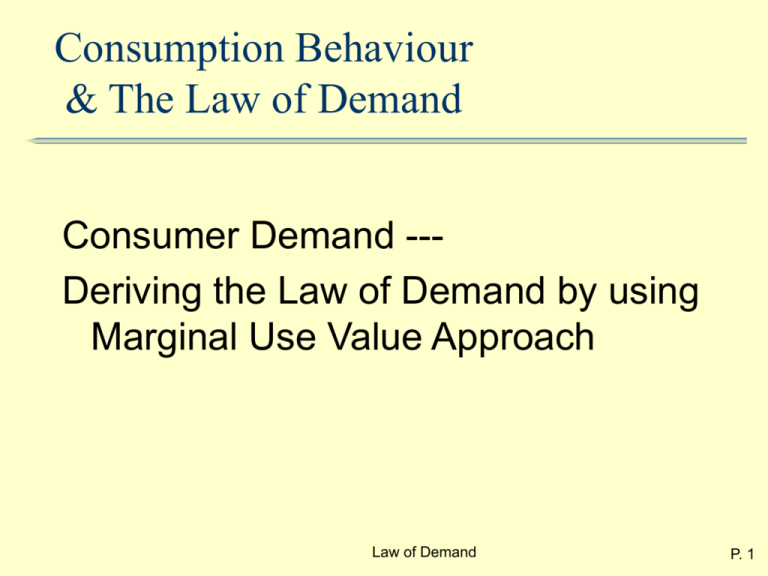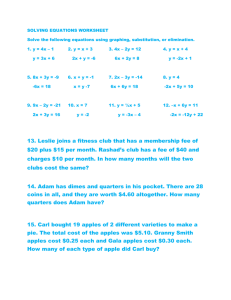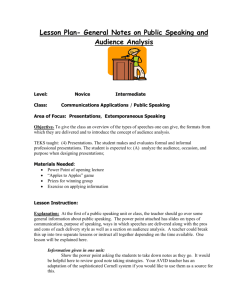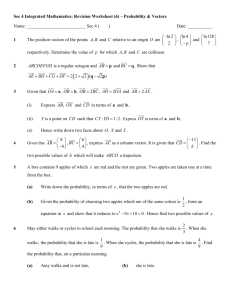Document
advertisement

Consumption Behaviour & The Law of Demand Consumer Demand --Deriving the Law of Demand by using Marginal Use Value Approach Law of Demand P. 1 Six Behavioural Postulates of Choice Theory 1. Each individual desires and chooses many goods 2. Some goods are scarce for each individual 3. Not all people choose the same good since different individuals have different preferences Law of Demand P. 2 Six Behavioural Postulates 4. Individuals are consistent in choice 5. People are willing to sacrifice some of good in order to have more of another (goods are substitutable) 6 Obey the Principle of Diminishing Marginal Use Value, (the larger its TUV, the lower its MUV). Law of Demand P. 3 Use Value Use value of a good is defined as the maximum amount of another good a person is willing and able to sacrifice in order to obtain that good. Law of Demand P. 4 TUV & MUV Total use value (TUV) of a number of goods refers to the amount of other goods you are willing and able to forgo in order to obtain the total amount of that good. Marginal use value (MUV) of a good is the use value of an extra unit of a good to an individual. Law of Demand P. 5 Number of apples an Marginal use value individual possesses of apples per week ($) Total use value of apples ($) 0 - 0 1 10 10 2 9 19 3 8 27 4 7 34 5 6 40 6 5 45 7 4 49 Principle of Diminishing Marginal Use Value The principle (postulate) of diminishing marginal use values states that the more an individual acquires a good, the higher the total use value, but the lower the marginal use value of each additional unit of that good. Law of Demand P. 7 Deriving the Law of Demand To derive the law of demand, we have to introduce two concepts: 1. Consumer surplus 2. All individuals are Maximizers Law of Demand P. 8 Deriving the Law of Demand Consumer surplus is defined as the difference between total use value (TUV) and total exchange value (I.e. total expenditure) (TEV) of a good. That is the extra amount of consumer is willing to pay over and above what he or she actually pays. Consumer surplus = TUV - TEV Law of Demand P. 9 If the price of apples is $8 each, (1) how many apples will the consumer buy and (2) what is the amount of consumer surplus? Number of apples an individual possesses per week 0 1 2 Marginal use value of apples ($) 10 9 Total use value of apples ($) 0 10 19 3 4 8 7 27 34 5 6 7 6 5 4 40 45 49 If the price of apples is $8 each, (1) how many apples will the consumer buy and (2) what is the amount of consumer surplus? Number of apples an individual possesses per week 0 1 2 3 4 5 6 7 Marginal use value of apples ($) 10 9 8 7 6 5 4 Total use value of apples ($) 0 10 19 27 34 40 45 49 If the price of apples is $8 each, (1) how many apples will the consumer buy and (2) what is the amount of consumer surplus? Number of apples an individual possesses per week Marginal use value of apples ($) Total use value of apples ($) 0 - 0 1 10 10 2 9 19 3 8 27 4 7 34 5 6 40 6 5 45 7 4 49 Consumer surplus T U V - T E $27 ($8 3) $27 $24 $3 Marginal use value ($ per unit) MUV 11 10 Consumer surplus 9 8 7 6 5 4 3 2 1 Q 0 1 2 3 4 5 6 7 8 9 Apples (unit per week) 10 P MUV 11 10 9 8 7 6 5 4 3 2 1 0 MUV =DD Price ($ per unit) Marginal use value ($ per unit) People maximize consumer surplus Q 11 10 9 8 7 6 5 4 3 2 1 0 DD=MUV Consumer equilibrium A B Q 1 2 3 4 5 6 7 8 9 10 1 2 3 4 5 6 7 8 9 10 Apples (unit per week) Apples (unit per week) Deriving the Law of Demand Since people maximize consumer surplus, hence the consumer equilibrium / maximization condition is : P MUV Law of Demand P. 15 Validating the Law of Demand Law of demand states that there is an inverse relationship between the price and quantity demanded, keeping all other things constant. Law of Demand P. 16 Validating the Law of Demand The empirical validity of the law of demand does not depend on whether we can prove it or not, it depends on whether it gives accurate predictions. Through many years of testing, economists have not found a valid opposite example that refutes this negative relationship, so this relationship is confirmed, and has been named as the law of demand. Law of Demand P. 17 Generalizing the Law of Demand two general types of generalization of the law of demand: 1. Price and Cost 2. Relative Price Law of Demand P. 18 Generalization of the Law of Demand The ‘price’ of a good is the same as the ‘cost’ of obtaining the good. The concept of ‘price’ is not confined to ‘money price’, and should be generalized to ‘relative price’. I.e. the price of a good in terms of another good in real term Law of Demand P. 19 Real example Let the price of a high-quality wine costs $1,000 a bottle, and a low-quality wine costs $500 a bottle in France. When both of them are imported to Hong Kong, adding the transportation cost of $100 per bottle, the high-quality wine will now cost $1,100 and the low-quality one will cost $600. What are the relative prices of high-quality wine and low-quality wine in France and Hong Kong? Real example France Relative price of high-quality wine in terms of low-quality wine Relative price of low-quality wine in terms of highquality wine Hong Kong decrease $1,000 2 $500 $1,100 1.83 $600 $500 0.5 $1,000 $600 0.55 $1,100 increase Real example According to the law of demand, the decrease in relative price of the good wine raise the quantity demanded of it, while the increase in relative price of the poor wine will reduce the quantity consumed. As a result, Hong Kong people will consume a higher percentage of good wine than France! The Paradox of Value Water-Diamond Paradox : “Why is the price of water, which is essential to human life, so much lower than that of diamonds, which are merely for decorative propose?” Law of Demand P. 23 The Paradox of Value: Water-Diamond Paradox The Solution: Demand & Supply Analysis Using marginal analysis on the use value I.e. Total Use Value at the margin ( MUV ) Law of Demand P. 24 Water-Diamond Paradox Demand & Supply Analysis – Since the supply of water is much larger than the supply of diamonds, the price of a diamond is much higher than that of water. Law of Demand P. 25 Water-Diamond Paradox TUV and MUV ----The ‘value’ of a good depends on the ‘total use value’ (TUV) of it. Since the quantity of water consumed by the people is much larger than the quantity of diamonds, the TUV of water should also be larger than that of diamonds. Law of Demand P. 26 TUV P P S TUV D=MUV 0 Q Diamond (unit per week) S D=MUV Q 0 Water (unit per week) Water-Diamond Paradox TUV and MUV – The ‘value’ of a good depends on the ‘total use value’ (TUV). – The price of a good depends on the ‘marginal use value’ (MUV) of the last unit of a good consumed by people. Law of Demand P. 28 P=MUV P=MUV P P S S D=MUV 0 Q Diamond (unit per week) D=MUV 0 Q Water (unit per week) Individual & Market Demand Curves To derive the market demand curve, we have to distinguish two kinds of goods, the private good and the public good. Law of Demand P. 30 Individual & Market Demand Curves Private good is defined as a good that can only be consumed by one individual at a time. Public good is defined as a good that can be jointly consumed by many people at the same time without additional cost. Law of Demand P. 31 Person A Person B Market Price of apples ($) Quantity demanded of apples per week Quantity demanded of apples per week Quantity demanded of apples per week 11 0 0 10 1 0 9 2 2 8 3 4 7 4 6 6 5 8 5 6 10 4 7 12 3 8 14 2 9 16 1 10 18 Person A Person B Market Price of apples ($) Quantity demanded of apples per week Quantity demanded of apples per week Quantity demanded of apples per week 11 0 0 0 10 1 0 1 9 2 2 4 8 3 4 7 7 4 6 10 6 5 8 13 5 6 10 16 4 7 12 19 3 8 14 22 2 9 16 25 1 10 18 28 P P P 11 10 9 DA DB DA+B 4 3 7 Person A Q 4 12 Person B Q 7 19 Market Q






